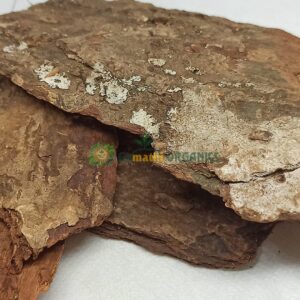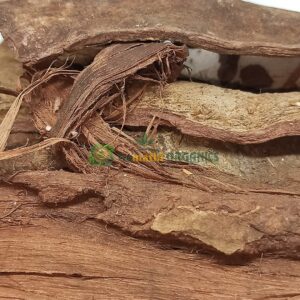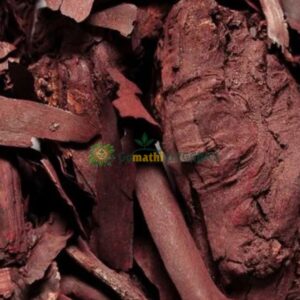🌿 What is Mara Manjal Powder?
Mara Manjal Powder is a traditional herbal remedy derived from the dried root and stem of Coscinium fenestratum, commonly known as “Mara Manjal” (மரமஞ்சள்) in Tamil, “Daru Haldi” in Hindi, and “Yellow Vine” in English. Esteemed in Ayurveda, Siddha, and Tamil folk medicine, this powder is renowned for its potent antimicrobial, anti-inflammatory, and detoxifying properties.
🌿 Description of the Mara Manjal (Coscinium fenestratum) Plant
- Botanical Name:Coscinium fenestratum
- Family:Menispermaceae
- Common Names:Tree Turmeric, Yellow Vine, Mara Manjal (Tamil), Daru Haldi (Hindi), Maramanjal (Malayalam), Kasturipushpa (Telugu)
Mara Manjal is a woody climber native to the tropical forests of South and Southeast Asia. It thrives in humid, shaded environments and is often found in the Western Ghats of India.
🌿 Morphological Characteristics of Mara Manjal
- Growth Habit:Woody climber with a lifespan of up to 25 years.
- Leaves:Leathery, glossy, and dark green.
- Stems:Thick, woody, containing vibrant yellow sap.
- Flowers:Small, yellowish, and dioecious (separate male and female plants).
- Fruits:One or two-seeded drupes, up to 2 cm in diameter.
- Roots:Thick and fibrous, rich in medicinal compounds.
✨ Uses & Benefits of Mara Manjal Powder
🩺 Liver Health & Detoxification
- Supports liver function and aids in detoxifying the body.
- Traditionally used in managing jaundice and other hepatic disorders.
💪 Anti-Inflammatory & Pain Relief
- Reduces inflammation and alleviates pain associated with arthritis and other inflammatory conditions.
- Applied topically for treating wounds, ulcers, and skin inflammations.
🌸 Digestive & Metabolic Support
- Aids in digestion and helps manage conditions like diarrhea and flatulence.
- Used in traditional medicine to regulate blood sugar levels, benefiting those with diabetes.
🌿 Women’s Health
- Employed in treating menorrhagia (heavy menstrual bleeding) and other menstrual disorders.
- Provides relief from spasmodic abdominal pain and leucorrhea.
🛡️ Antimicrobial & Immune Support
- Exhibits strong antimicrobial properties, helping combat infections.
- Boosts overall immunity and supports the body’s natural defense mechanisms.
⚠️ Precautions & Safety Information
- Consult a healthcare professional before use, especially if pregnant, breastfeeding, or on medication.
- Not recommended for children without medical supervision.
- Excessive consumption may lead to gastrointestinal discomfort.
🌱 Mara Manjal Powder Organic Information
- 100% natural and traditionally processed.
- Free from pesticides, additives, and synthetic chemicals.
- Sourced from sustainable and uncontaminated environments.
- Dried under shade to preserve medicinal properties and finely powdered.
- Widely used in Ayurvedic, Siddha, and Tamil folk remedies for holistic healing.
⭐ Family Name: Menispermaceae
⭐ Botanical (Latin) name: Berberis aristata DC. (Berberidaceae), Coscinium Fenestratum
⭐ Sanskrit: Daruharidra (दारुहरिद्रा), Darvi, Darurajani, Katamkateri
⭐ English: Yellow Vine Root, Tree Turmeric, Indian Berberry, False calumba, Indian Barberry, Nepal Barberry
⭐ Tamil: Mara Manjal / மர மஞ்சள், Kasturimanjal
⭐ Hindi: Daru haldi / दारू हल्दी, Chitra, Chotra, Dar-chob
⭐ Telugu: Pachha Pasupu (పచ్చ పసుపు), Mardaa arashinaa ಮರ್ದಾ ಅರಶಿನಾ, Manu Pasupu మను పసుపు, Kasthoori pushpa, Kasturipaspu
⭐ Kannada: Bagisutra, Baagi soothra, Daruhaladi / Mardaa arashinaa ಮರ್ದಾ ಅರಶಿನಾ,
⭐ Malayalam: Maramanjal / മരമഞ്ഞൾ/ Maramannal
⭐ Marathi: Venivel वेनिव्हल / Daruhalad दारूहळद
⭐ Urdu: Darhald
⭐ Punjabi: Sumalu, Daruharidra (ਦਾਰੂਹਰਿਦ੍ਰਾ)
⭐ Bengali: Daruharidra
⭐ Gujarati: Daruharidra, Daruhuladur
⭐ Odia: Daruharidra (ଦାରୁହରିଦ୍ରା), Daruhalidi
⭐ Assamese: Daruharidra (দাৰুহৰিদ্ৰা)
⭐ Urdu: Aarghis , Daru Haldi (دارو ہلدی), Darhald nim kofta
⭐ Konkani: Haladi Mara
⭐ Tulu: Mara Arshina
⭐ Meitei (Manipuri): Hing Morok
⭐ Dogri: Daru Haldi
⭐ Kashmiri: Daru Halad
⭐ Maithili: Daruharidra
⭐ Chhattisgarhi: Daruharidra
⭐ Rajasthani: Daruharidra
⭐ Sindhi: Daru Haldi
⭐ Nepali: Baarhamaase Chutro (बाह्रमासे चुत्रो), Daru Haridra (दारु हरिद्रा)
⭐ Arabi: Kurkum Al-Jadari (كركم الجداري)
Nutrition Facts (Approximate per 100 g of Dried Berberis aristata)
❦ Calories: 50 kcal
❦ Protein: 1.2 g
❦ Fat: 0.4 g
❦ Carbohydrates: 11 g
❦ Fiber: 4 g
❦ Sugar: 0.6 g
❦ Iron: 5 mg
❦ Calcium: 30 mg
❦ Vitamin C: 20 mg
❦ Potassium: 200 mg
Nutritional Information
🌻 Vitamin C, berberine, antioxidants, small amounts of calcium and magnesium.
Recommended Dosage
❦ Capsules: 500 mg, 1-3 times daily.
❦ Tincture: 10-20 drops, 2-3 times a day.
❦ Tea/Powder: 1-2 grams in hot water, 1-2 times per day.
❦ Fruit powder – 3-5gm
❦ Fruit extract – 3gm
How to consume Internally
🌼 Morning – Mix 1/4 teaspoons of Mara Manjal Powder with 100ml of warm water daily after Food. Repeat the same for the Evening Dosage after dinner. as directed by your health Practitioner.
🌼 Take 5 grams of yellow vine powder and mix it with 100 ml of water. Boil the mixture. Consume the mixture every morning and evening to treat diabetes.
🌼 Mix 1/4 tsp of Maramanjal powder with warm water, honey, or herbal tea.
🌼 Use in cooking or herbal blends for added benefits.
How to Apply Externally
🌼 Prepare a paste with Maramanjal powder and rose water for skin application.
🌼 Create a face mask by mixing with turmeric and sandalwood powder
🌼 Use in baths to detoxify the skin and promote relaxation.
🌼 Combine with neem powder to treat dandruff and scalp issues.
Daily Life: How to Use
🌼 Oral: Add powder to teas, and smoothies, or take in capsule form.
🌼 Topical: Apply paste for acne or skin irritation.
🌼 Tincture: Use a few drops under the tongue or in water.
How to Store
☀️ Keep in an airtight container away from moisture and direct sunlight.
☀️ Ensure the lid is tightly closed after every use.
🌼 SCIENTIFICALLY TESTED & COMPLETELY SAFE. SUITABLE FOR VEGETARIANS. NOT TESTED ON ANIMALS/NO ANIMAL INGREDIENTS. NO KNOWN SIDE EFFECTS. COMPLETELY SAFE. NON-TOXIC. FREE FROM HEAVY METALS 🌻
Caution to Be Taken
⚡ Consult a physician if pregnant, breastfeeding, or on medication.
⚡ There may be interactions with medications, particularly those affecting blood sugar and blood pressure levels.
⚡ Avoid excessive consumption to prevent toxicity.
⚡ Not suitable for infants or children without medical advice.
⚡ Not recommended for long-term use without medical guidance.
⚡ Always consult a healthcare provider for personalized dosage.
Important Tips
☀️ Initiate 🌱 with a Low Dose: Start with a minimal amount to observe how your body responds.
☀️ Use Moderately: 🌿 Avoid excessive, long-term use without guidance
Prioritize Quality: Purchase from 🍁 trusted vendors to ensure product purity
☀️ Conduct a Patch Test: Always conduct a 🍂 patch test before applying to the skin
☀️ Storage Considerations: Avoid metal containers to 🍃 maintain the product’s effectiveness.
☀️ Discover Pairing Options: Think about combining with other🌾 herbs like Daruhaldi and black pepper to enhance absorption
Harvesting & Manufacturing Method
☀️ All of our herbs are harvested organically, dried, and ground without chemical interaction, guaranteeing 🌳 that our herbal powders and related products are entirely natural.
☀️ Sourced from sustainably 🌿 cultivated Coscinium plants found in tropical mountains and forests.
☀️ These herbs are carefully picked by🌱 hand and dried in the sun to maintain and preserve, their nutritional benefits.
☀️ They are Processed without any additives or chemicals, 🌾 ensuring, and guaranteeing their natural purity.









Reviews
There are no reviews yet.